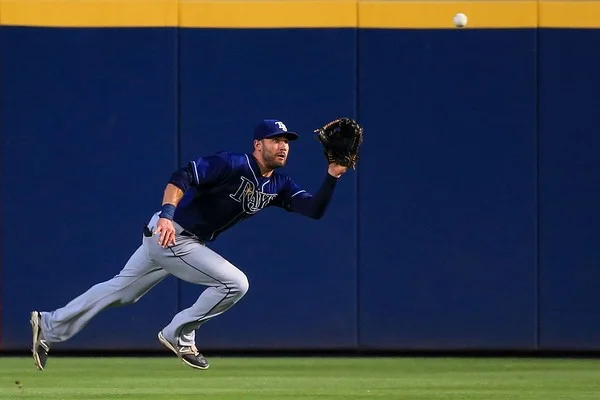Range
Each of the drills also begins to work the outfielder on his range. Range applies to both balls on the ground and balls in the air for all defensive players. An outfielder must be willing to cut balls off in the gap by exercising excellent angles, footwork and hustle, while also being able to chase down balls over his head. He must also show a desire to not let any ball get by him or drop in front of him. Again the Line Drill, this time with range and a spin throw, along with the Pitchfork, Alleys, and Live work will help the outfielder develop these skills. During the Team Defense section, the Cuts and Relays drill will help develop range in outfielders as well.
Movement
An outfielder will display certain movements that indicate excellent outfielding. He will take his eyes off the ball to get to a certain spot to chase down a flyball. More area in the outfield can be covered, and catches made, when an outfielder runs for three or four strides and looks away for the ball. He will track the baseball exceptionally well by looking into the hitting area to get good jumps. A good outfielder will anticipate and move before anyone in the ball park sees that the ball is hit to him. He will creating a mental image of the trajectory of the ball is crucial for developing this skill. An outfielder can exercise the spin move to catch and get rid of the ball quickly. When chasing the ball, either in the air or on the ground, he will run with the glove in and close to his body and not out, displaying proper running form. An outfielder runs and doesn’t drift to get to the ball and shows good feel around the walls to make catches. All of these elements require a ton of practice but can be developed in all outfielders through the drill series recommended.
There are three phases of movement during a play for outfielders: Pre-pitch, Pitch, and Post-pitch. Pre-pitch movements indicate the player is adjusting to these five categories: the elements (wind, weather, etc.), his alignment, what he anticipates the batter will do at this point, what the outfielder will do if the ball is hit to him, and factoring the score of the game at the moment into the equation. By adjusting to these things, the outfielder will show a level of readiness in his movements. During the pitch, an outfielder will move into an athletic or ready position and follow the ball from the pitcher into the hitting zone. These movements will indicate that the outfielder is expecting the ball on every play. Post-pitch, the outfielder will adjust all of the items from the pre-pitch and talk to the other outfielders about the necessary adjustments. As a dramatic example of the kind of movement and engagement that should happen between all players, including outfielders on every play, watch this commercial from Dick’s Sporting Goods.

